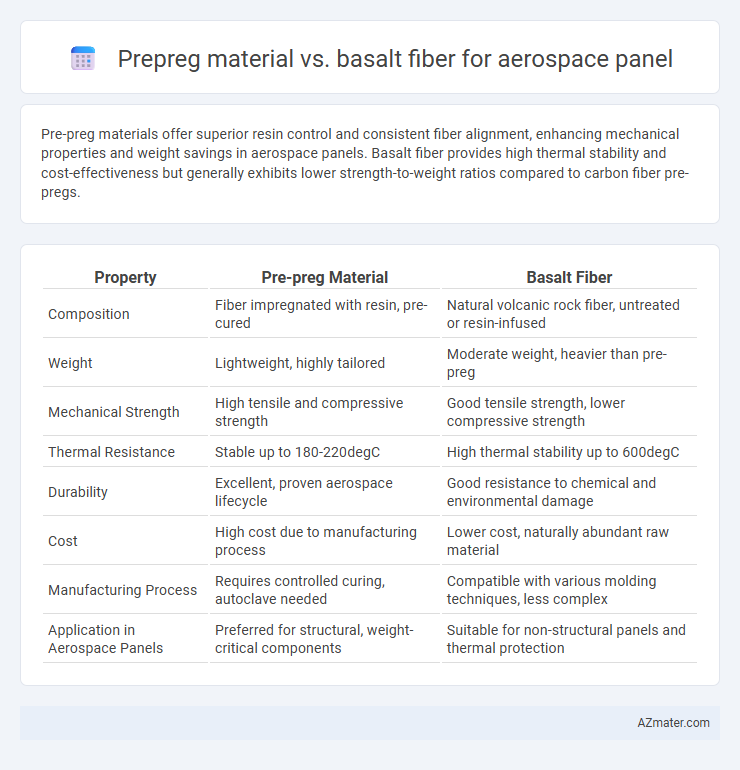Pre-preg materials offer superior resin control and consistent fiber alignment, enhancing mechanical properties and weight savings in aerospace panels. Basalt fiber provides high thermal stability and cost-effectiveness but generally exhibits lower strength-to-weight ratios compared to carbon fiber pre-pregs.
Table of Comparison
| Property | Pre-preg Material | Basalt Fiber |
|---|---|---|
| Composition | Fiber impregnated with resin, pre-cured | Natural volcanic rock fiber, untreated or resin-infused |
| Weight | Lightweight, highly tailored | Moderate weight, heavier than pre-preg |
| Mechanical Strength | High tensile and compressive strength | Good tensile strength, lower compressive strength |
| Thermal Resistance | Stable up to 180-220degC | High thermal stability up to 600degC |
| Durability | Excellent, proven aerospace lifecycle | Good resistance to chemical and environmental damage |
| Cost | High cost due to manufacturing process | Lower cost, naturally abundant raw material |
| Manufacturing Process | Requires controlled curing, autoclave needed | Compatible with various molding techniques, less complex |
| Application in Aerospace Panels | Preferred for structural, weight-critical components | Suitable for non-structural panels and thermal protection |
Introduction to Aerospace Panel Materials
Pre-preg materials, consisting of fiber reinforcements pre-impregnated with resin systems, offer superior mechanical properties and precise resin content control critical for aerospace panels. Basalt fiber, derived from volcanic rock, provides excellent thermal stability, high strength-to-weight ratio, and enhanced resistance to corrosion and fire, making it a promising alternative for aerospace panel construction. Selecting between pre-preg composites and basalt fiber depends on specific aerospace requirements such as weight reduction, durability, and manufacturing efficiency.
Overview of Pre-preg Materials
Pre-preg materials consist of fibers pre-impregnated with a precise amount of resin, typically epoxy, ensuring uniform matrix distribution and superior mechanical properties for aerospace panels. These materials offer high strength-to-weight ratios, excellent fatigue resistance, and consistent curing processes that enhance dimensional stability in aerospace applications. Pre-pregs support complex panel geometries and provide optimized performance under extreme environmental and mechanical stresses compared to basalt fiber composites.
Understanding Basalt Fiber Composition
Basalt fiber, derived from natural volcanic basalt rock, consists primarily of silica, alumina, and iron oxides, offering superior thermal stability and chemical resistance compared to conventional carbon-fiber-based pre-preg materials used in aerospace panels. Its unique composition results in enhanced durability and improved mechanical properties under high-temperature conditions, making it a lightweight alternative with excellent fireproofing capabilities. Basalt fiber's natural origin and cost-effective production process also contribute to its growing application in aerospace structural panels where strength-to-weight efficiency is critical.
Mechanical Properties Comparison
Pre-preg materials offer superior mechanical properties such as higher strength-to-weight ratio and enhanced fatigue resistance compared to basalt fiber, making them ideal for critical aerospace panel applications. Basalt fiber provides commendable tensile strength and impact resistance but generally falls short of the stiffness and thermal stability exhibited by advanced carbon or glass fiber pre-pregs. The choice between pre-preg composites and basalt fiber depends on specific performance requirements, with pre-pregs favored for optimized load-bearing and durability in aerospace structural panels.
Weight and Density Analysis
Pre-preg materials offer precise resin control with a density typically around 1.5 g/cm3, enabling lightweight aerospace panels with optimized structural strength. Basalt fiber, denser at approximately 2.6-2.8 g/cm3, provides enhanced thermal stability and impact resistance but results in heavier panels compared to pre-preg composites. Weight-critical aerospace applications often favor pre-preg materials due to their lower density and superior strength-to-weight ratio, while basalt fiber panels are selected for environments demanding robust durability despite increased mass.
Thermal Resistance and Fire Performance
Pre-preg materials, composed of resin-impregnated fibers, exhibit superior thermal resistance with glass transition temperatures often exceeding 200degC, making them ideal for aerospace panels exposed to high operational temperatures. Basalt fiber offers excellent fire performance due to its natural mineral composition, providing inherent flame retardancy and non-combustibility without additional chemical treatments. While pre-preg composites provide high strength-to-weight ratios and tailored thermal properties, basalt fiber panels deliver enhanced fire resistance and cost-effective thermal insulation suitable for stringent aerospace safety standards.
Durability and Environmental Resistance
Pre-preg materials offer superior durability in aerospace panels due to their controlled resin content and uniform fiber distribution, resulting in enhanced mechanical properties and fatigue resistance. Basalt fiber provides excellent environmental resistance, including high thermal stability, corrosion resistance, and impact tolerance, making it suitable for harsh aerospace conditions. While pre-pregs deliver consistent performance and weight savings, basalt fibers excel in resisting extreme temperatures and chemical degradation, offering a robust alternative for aerospace panel durability.
Manufacturing and Processing Considerations
Pre-preg materials offer precise fiber alignment and resin content control, streamlining aerospace panel manufacturing with enhanced repeatability and reduced processing time through out-of-autoclave curing techniques. Basalt fiber, while providing superior mechanical and thermal properties, requires adjustments in processing parameters due to its higher melting point and different resin compatibility, affecting lay-up and curing processes. Manufacturing with basalt fiber demands tailored tooling and optimized curing cycles to ensure fiber-matrix bonding and avoid defects, contrasting with the more standardized procedures of pre-preg composites.
Cost Analysis: Pre-preg vs Basalt Fiber
Pre-preg composites typically exhibit higher upfront costs due to expensive resin systems and extensive processing requirements compared to basalt fiber, which offers a more cost-effective raw material and simpler manufacturing process. Basalt fiber provides a lower cost per kilogram and reduced curing time, significantly decreasing labor and energy expenses in aerospace panel production. Despite pre-preg's superior mechanical properties and fiber-matrix adhesion beneficial for high-performance aerospace applications, basalt's economic advantage makes it a competitive alternative for cost-sensitive structural panels.
Application Suitability in Aerospace Panels
Pre-preg materials offer superior fiber-resin control, enabling precise mechanical properties and consistent quality essential for aerospace panels requiring high strength-to-weight ratios and excellent fatigue resistance. Basalt fiber, with its natural thermal stability, corrosion resistance, and cost-effectiveness, suits aerospace panels exposed to harsh environmental conditions or where fire resistance is critical. Selection depends on the specific aerospace application demands, balancing performance criteria such as stiffness, impact resistance, and environmental durability.

Infographic: Pre-preg material vs Basalt fiber for Aerospace panel
 azmater.com
azmater.com